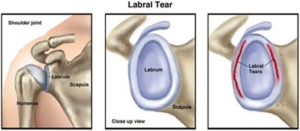What is a Shoulder Labrum Tear?
Reverse Bankart and Plication Repair
Surgery performed by Dr. Chams
SLAP Repair
Surgery performed by Dr. Chams
Non-Suture Knot Labral Repair
Surgery performed by Dr. Chams
Knotless Labral Repair
3D Surgical Animation
The shoulder joint is the body’s most mobile joint but this luxury of mobility can come with consequences of injury. The shoulder complex is a ball and socket joint and is comprised of 4 main muscles, several bones and several soft tissue structures. The scapula (shoulder blade), clavicle (collar bone), and humerus (upper arm bone) make up the bony components. The upper end of your arm bone (humerus) rests within the scapular socket (glenoid). The resting area of the glenoid is rather shallow and unstable. However, your labrum increases the stability by deepening the area by 50%. Your labrum is anatomically divided into several compartments including the top or superior (SLAP), anterior (bankart) and posterior (reverse bankart).

Your labrum, which consists of strong fibrous tissue, can be injured from a variety of traumatic events such as a subluxation or dislocation from a fall or a direct blow; with repetitive overuse such as throwing a baseball or even an industrial athlete that performs overhead tasks daily such as a painter or electrician. Injury can also be a results of one’s genetic disposition or joint laxity.
Signs of a Torn Shoulder Labrum
Symptoms can range from decreased range of motion, lost strength and stability, painful movement, locking, catching, popping and grinding. These symptoms usually occur with activities overhead or away from your chest.
Diagnosis of a Shoulder Labrum Tear
Diagnosis can be determined through a thorough history and physical examination by a trained sports medicine and orthopedic shoulder specialist. Once the initial diagnosis has been made though special anatomical testing, an MRI arthrogram (3 dimensional picture with contrast injection) may be ordered to confirm the diagnosis and assist in determining the severity of the tissue injury. Occasionally, X-rays of the shoulder complex will be ordered to determine if any bony conditions exist prior to your MRI arthrogram. X-rays will not show damage to the soft tissue, hence the need for an MRI scan.
Torn Shoulder Labrum Treatment Options
Treatments can include conservative verses surgical management. A specific individualized treatment program will be created from your thorough history, physical examination and radiological testing. Conservative management can consist of anti-inflammatory medications, a cortisone injection, orthobiologics, physical therapy and/or rest. Treatment conservatively can last 6-12 weeks before returning to specific functional overhead tasks/activities. Surgical management may be recommend depending on the severity of the damage of the labrum and if conservative treatments have failed. Failed treatment would consists of continued pain, lost motion due to instability, weakness and the inability to perform work or sport specific activities and tasks. Labral tears are surgically repaired under arthroscopic intervention.
Shoulder Arthroscopic Surgery for Torn Labrum
Shoulder arthroscopy, occurs when a small camera is placed into the shoulder joint to visualize the labral damage. During this visualization, ligaments, bones and muscles of the shoulder complex is further assessed by the orthopedic surgeon. Once the assessment has been completed the surgeon uses a variety of instrumentation to repair the fibrous complex and ligaments to re-stabilize the shoulder. The tissue is repaired and reattached with either bio-composite or knotless suture anchors.
Video – Surgical Labral Repair
Torn Shoulder Labrum Recovery in Illinois
Rehabilitation post operatively will begin immediately. Patients will be placed into a sling for 4-6 weeks. A home exercise program will begin immediately following surgery. These exercises will be performed until formal rehabilitation can begin one to two weeks post-surgical repair pending its severity. A physical therapist or athletic trainer will begin your formal rehabilitation through a planned rehabilitation protocol. Initial outpatient sessions will consist of obtaining pain-free passive range of motion. Strengthening of the shoulder complex will begin around the 8-10 week post-operative phase once range of motion has been achieved. Total recovery from labral repair can range from 4-8 months depending on the extent of the tear and specific sport.
